Table of Contents
Overview
The 1970 Sencore CR70 "Beam Builder" Universal CRT Analyzer & Restorer is a popular budget option for testing CRTs. Its strongest sales points during its heyday was the powerful set of adapters that were included. 5 double-sided adapters and one universal adapter (clip leads) meant you could conceivably test every CRT ever made - even ones which came out after the tester was released.
While the compatibility is impressive, the accuracy of the cutoff and emissions testing unfortunately falls short for modern CRTs. This tester is a strong contender for the pre-1980s CRTs it was designed to test but its low G1 bias and low G2 voltage are not enough to accurately test CRTs that came later. Additionally it has an unfortunate design flaw (more on this below) where G1 bias is not even applied for emissions testing. The CR70 only has one emissions meter, which means it can only test one color gun at a time. Although there is a built-in tracking "memory" that allows you to do a tracking test, the procedure to do this is very convoluted it would have been preferable to be able to test all 3 guns at once.
Key Features
In addition to the standard/expected features of a CRT Tester, the CR70 has these additional key features:
- Unbeatable set of socket adapters included that cover every CRT ever made.
- Selectable G1 bias presets: 20v, -36v, -52v, -68v for cutoff testing (unfortunately this setting is ignored during emissions testing, G1 resets to 0v)
- VIDEO / SCOPE / PROJ test modes for testing normal CRTs as well as oscilloscope and projector CRTs. This selector changes the bias of the emissions good/bad meter scale for each type of tube.
- Full range of filament voltage choices from 1 to 14v
- Self-limiting G1 Shorts Clearing (current only flows if there is actually a short, no damage can occur to a tube without shorts)
- "Extended G1 Shorts Clearing" feature for stubborn shorts in CRT projector tubes.
Buyer's Guide
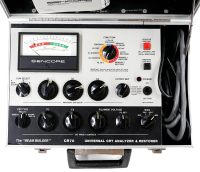
Read the OEM-Adapters section below to learn about what adapters should come with your tester. I don't suggest buying this tester without all of the adapters being included, though you can get away with just the universal adapter.
The top half of the briefcase is a storage pouch for socket adapters and if you are considering buying one, you should check to make sure all 6 adapters (5 plastic and one set of clip leads) are included within the pouch. Each of the plastic adapters is double-sided, totaling 10 different socket adapters.
In front of the sockets pouch is a board with two book holders mounted to it. One should be holding the Operation Manual and the other should be holding the Sencore CRT Set-up Booklet. If these are missing (or even broken off entirely) it should lower the value of the tester. The contents of both of these booklets are available online in PDF format (see Manuals & Set-up Charts).
When looking at the knobs, I've noticed that some models have black notched covers that display only one number at a time, while others don't have these covers. I don't know if they just fell off over the years or if Sencore had multiple revisions of the tester with different styles of knobs. The owner's manual for the CR70 shows the black notch covers in all of the illustrations so it's probably more likely that they should be present on all models and some fell off over the years. Regardless, this does not affect the operation or value of the tester in any way, its just a convenience feature to make the tester more readable during the tube set-up process.
Sencore CRT Testers are pretty rock-solid so there's not much to worry about with their operation condition, as long as they don't look visually abused and have all of their knobs in-tact. The tester should have two wires coming out of it - one grey wire for tube connections and one black AC plug for power. The red POWER light should glow if the tester is plugged into the wall and the POWER switch is set to ON.
Current value for the CR70 (as of May 2023) should be around $150-200+ if some adapters are included, or around $75-125 with fewer adapters included. I don't recommend buying this tester at all if the Universal Adapter is not included.
Words of Caution
I mentioned briefly earlier in this page that there are some downsides to this tester, and they should not be ignored. If you are looking for a good, low-budget, all-around tester and restorer for vintage tubes then you will likely enjoy the Sencore CR70. However I would suggest anyone looking for the most accurate test results (especially for modern tubes) and safer rejuvenation settings look for a more expensive tester such as the Sencore CR7000 or BK 467 / 490.
Main problems with the CR70:
- G1 bias is not used for emissions testing, providing woefully inaccurate (often erroring on the side of optimistic) tube emissions results
- No selectable G2 voltage (meaning any tube that requires a G2 voltage greater than the tester supports cannot be tested accurately for cutoff) - max supported is 350v.
Manuals & Set-up Charts
- CR70 Owner's Manual
- CR70 Schematic & Parts List
- CR70 Field Test Manual
- CR70 CRT Set-up Book - Latest 1991
- Ultimate Sencore Spreadsheet (covers the CR-31, CR-70, and CR-7000, and gives heater voltages and pinout information that is useful for ALL testers)
Maintenance Checks
Field Test
This handy PDF covers checking the functionality of every feature on the Sencore CR70 including checking heater voltage etc. You should complete this whole process before using the CR70 on a CRT.
Capacitors
To ensure the tester works properly in shorts clearing and rejuvenation modes you should check the health of the capacitors. The Schematic & Parts list contains a list of capacitors in the tester - you should focus on checking the "Lytic" ones as these are the ones most likely to go bad with age There are not many of them if you wish to just replace them with fresh ones without testing first. There is a very important 450v electrolytic cap (C14) that operates the G1 shorts clearing.
Socket Adapters
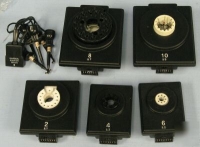
OEM Adapters
The Sencore CR70 comes with 5 plastic adapters and 1 clip lead adapter (called the Universal Adapter). Each of the plastic adapters are double-sided with different sockets/pinouts on each side, giving you a total of 10 different socket adapters covering the most common CRTs (at the time of production). Any CRT which is not compatible with the plastic adapters will require use of the Universal Adapter.
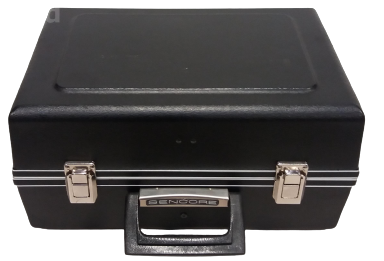
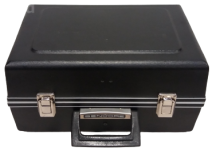
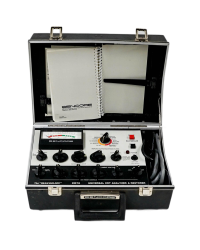
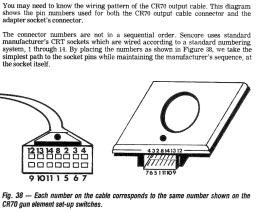
 This work is licensed under a
This work is licensed under a